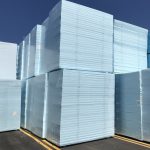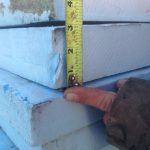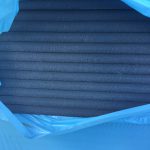Extruded polystyrene (XPS)
XPS is most often used in below grade applications because of its inherent resistance to absorbing water. XPS falls in the middle of the three types of rigid-foam insulation in R-value (about R-5 per inch). XPS typically comes unfaced. Unfaced 1-in.-thick XPS has a perm rating of around 1, making it semipermeable and is considered a vapor retarder, not a vapor barrier. The traditional blowing agents used to make XPS have a very high global warming potential. US Manufacturers are currently testing and introducing a new generation of blowing agents that dramatically reduce global warming potential. Thermal drift, the gradual lowering of R-value over time, is a consideration with both XPS and ISO.
Click on below thumbnails to see the big images:
Common Applications:
- Below Grade Applications: foundation walls, basement walls, basement floors
- Below Slab: radiant heating systems
- Walls and Ceilings
- Low Slope Roofing
- Pipe and Utility Line
- Earth Stabilization
Learn More:
- Adapted from article: Rick Arnold, The Daily Fix (Online) “Which Rigid Insulation Should I Choose?”, Fine Homebuilding, https://www.finehomebuilding.com/2009/05/01/which-rigid-insulation-should-i-choose (Accessed: August 31, 2020)
- Extruded Polystyrene Foam Association (XPSA) https://xpsa.com/
- August 7, 2020, “Owens Corning Introduces FOAULAR NGX Insulation”, Business Wire, https://newsroom.owenscorning.com/all-news-releases/news-details/2020/Owens-Corning-Introduces-FOAMULAR-NGX-Insulation/default.aspx
- June 1, 2020, “Avoiding the Global Warming Impact of Insulation”, Blog Post, Building Green https://www.buildinggreen.com/news-article/avoiding-global-warming-impact-insulation
- March 8, 2016, Allison Bailes, “Foam Insulation, global Warming Potential, and BS” Blog, Energy Vanguard, https://www.energyvanguard.com/blog/foam-insulation-global-warming-potential-and-bs





